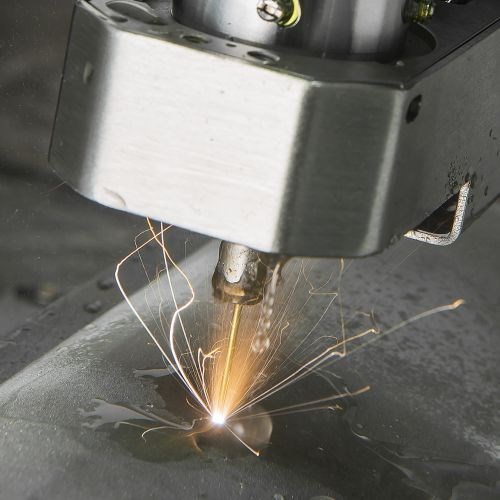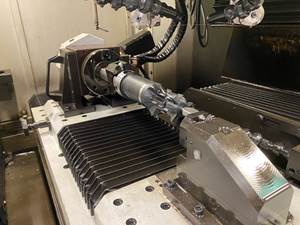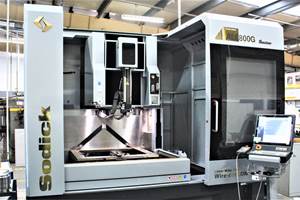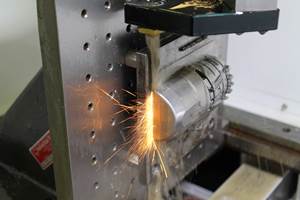EDM’s Key Technologies Today
A representative of machine maker Chmer lists some of the features and capabilities that hold the most promise for EDM users now.
Share



Hwacheon Machinery America, Inc.
Featured Content
View More


Takumi USA
Featured Content
View More


There was a time when EDM machine maker Chmer (Taichung City, Taiwan) might have expected high speed milling to take the place of a significant amount of die sinker EDM work. The company developed a line of high speed milling machines to complement its sinker, wire and holemaking EDM machines in anticipation of this change. But things didn’t work out that way—illustrating, among other things, how difficult it is to predict technology adoption. On a recent trip to Taiwan, I had a chance to speak about this with Chmer Marketing Director Brad Wang.
While the ability to take fast, accurate cuts at high feed rates potentially makes milling a contender for certain complex die/mold forms that sinker EDM is used to produce, EDM is still more efficient for features such as deep cavities, fins and many thin walls. These features occur just often enough that high speed milling has not been able to unseat the established technology to any considerable extent. However, high speed milling has proven popular among Chmer’s customers nevertheless, not as a replacement for EDM but as a complement. The fast, accurate cutting is efficient for roughing complex mold forms before the sinker EDM is used to complete those features that EDM is still the best at finishing.
Welcome! You’ve unlocked premium content.
The technology needs and preferences of customers reveal themselves over time, Mr. Wang says. His hope is for Chmer to continue to adapt. Here are the EDM features and capabilities right now that he sees as becoming increasingly important:
1. Linear Motors. Among each of the company’s EDM types (and its milling machines) are models equipped with linear motors for axis motion. Linear motor machines cost more than machines driven by ballscrews, Mr. Wang says, but these motors save cost through reduced maintenance while improving the accuracy of the machine. Compared to conventional drives, a wire EDM machine with linear motors can generate sharper corners on precise components such as die punches. More, linear motors maintain their accuracy over time. This is not the case with ballscrews, which wear and become less precise over time due to the ongoing surface-to-surface contact.
2. Machine Monitoring. Applications of EDM often involve rows of machines all running largely unattended because the cycles are so long. The unattended nature of the process makes the machines ideal for monitoring systems permitting remote viewing of the current status of the machine as well its performance history over time. Chmer’s in-house control has enabled the company to develop its own remote monitoring system, among other special features. (Read on.)
3. Ease of Use. The in-house control has also enabled Chmer to develop a programming system enabling inexperienced users to employ EDM effectively. An operator can enter the workpiece material and diameter of the wire along with the desired roughness of the machined surface to let the control automatically set the cutting conditions and parameters required.
4. Hole Making. Among the three EDM types, holemaking looks to offer the most potential for future growth, says Mr. Wang, thanks to the long-term likely demand for cooling hole machining in turbine components by the aerospace sector. Key capabilities here include precise CNC interpolation to give small holes with a diffuser (open funnel) form at the mouth, as well as integration with B-axis indexing for the array of angles characteristic of the set of holes in a typical blade.

Chmer’s AD4L is a linear-motor equipped holemaking EDM.
Related Content
Dielectric Oil Dramatically Reduces EDM Maintenance
Plagued by repeated small fires that interrupted its wire EDM throughput, this cutting tool manufacturer changed its dielectric oil and both eliminated fires and reduced its oil consumption.
Read MoreGF Machining Solutions Celebrates 70 Years of EDM Technology
GF Machining Solutions is celebrating the 70th anniversary of its discovery of EDM Technology.
Read MoreWall Colmonoy Acquires New Wire EDM From Sodick
The company will use the new wire EDM machine to increase capacity, improve cycle times, achieve tighter tolerances and improve surface finishes.
Read MoreEDM Network Wire EDM Features Four-Axis Cutting
The EDMMax 434W fast-wire EDM includes four-axis cutting capability that enables it to cut 3D support structures or other shop-related parts.
Read MoreRead Next
Building Out a Foundation for Student Machinists
Autodesk and Haas have teamed up to produce an introductory course for students that covers the basics of CAD, CAM and CNC while providing them with a portfolio part.
Read MoreSetting Up the Building Blocks for a Digital Factory
Woodward Inc. spent over a year developing an API to connect machines to its digital factory. Caron Engineering’s MiConnect has cut most of this process while also granting the shop greater access to machine information.
Read More5 Rules of Thumb for Buying CNC Machine Tools
Use these tips to carefully plan your machine tool purchases and to avoid regretting your decision later.
Read More





















.png;maxWidth=150)























